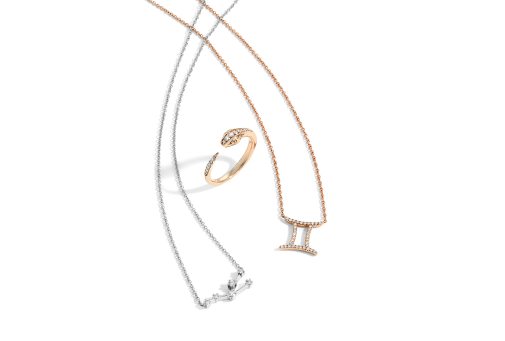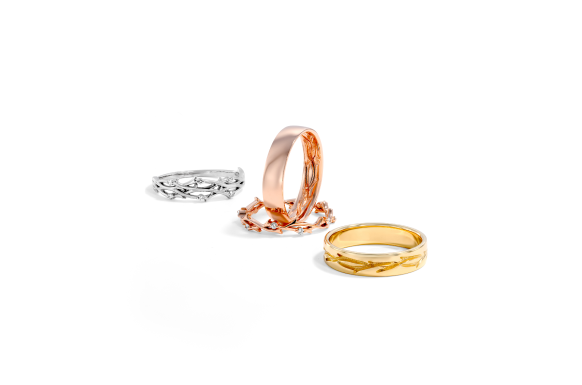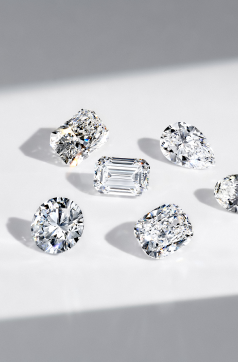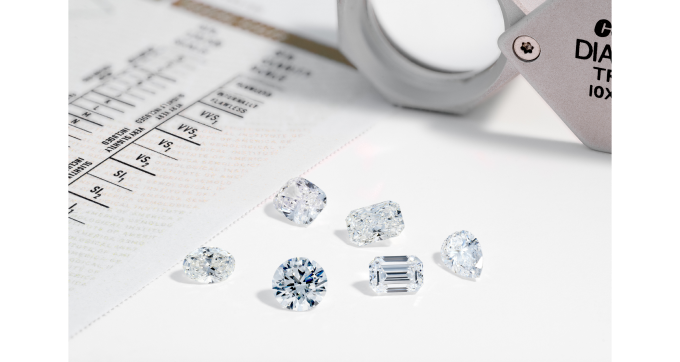When it comes to fine jewelry and especially engagement rings, rose gold and yellow gold are two iconic choices, each with its own mood. Rose gold brings a soft, romantic glow that feels modern yet delicate, while yellow gold has a rich sunlit warmth that never goes out of style. Each tells a different story, and both have the power to transform a piece of jewelry into something unforgettable.
Choosing the right metal is about finding the perfect match for your skin tone, style preferences, and lifestyle. Whether you’re drawn to the romantic blush of rose gold or the classic glow of yellow gold, let’s take a closer look at the pros and cons of each will help you make a confident decision.
What is Rose Gold?
Soft, romantic, and anything but ordinary, rose gold has captured the hearts of jewelry lovers everywhere. Its delicate hue offers a fresh alternative to traditional metals and brings a hint of warmth to any piece of jewelry. Here’s an overview of how it gets that gorgeous color and why it’s such a modern favorite.
Composition and How It Gets Its Color
Rose gold gets its signature color by mixing pure gold with copper and a touch of silver or zinc. The higher the copper content, the stronger the pink hue.
At Keyzar, our 14k rose gold is crafted from 58.5% pure gold and a proprietary blend of copper, silver, and zinc, creating a richer, more defined blush tone than its 18k counterpart, which contains 75% pure gold and has a softer, more subtle pink hue. Being softer due to its higher gold content, 18k rose gold is more prone to scratches and dents, but proper care can keep it looking flawless. Unlike white gold, rose gold doesn’t require rhodium plating to maintain its color. The pink tint you see is natural, born from the mix of metals in the alloy.
The Appeal of Rose Gold in Jewelry
Rose gold made its first splash in 19th-century Russia, when it was known as "Russian Gold." The Tsars adored it and centuries later, so do we. Today, it’s become a favorite among couples looking for something unique and meaningful.
Romantic and slightly vintage in tone, rose gold feels personal. It flatters every skin tone, complements a wide range of center stones, and pairs beautifully with both traditional and modern jewelry styles. Our customers especially love how rose gold brings out the brightness in colorful gemstones like green emeralds, making stones appear clearer than they are. From the soft shimmer of The Katelyn engagement ring to the modern elegance of The Riley diamond pendant, rose gold makes every design feel extra special.
Durability and Maintenance of Rose Gold
One of the unsung perks of rose gold is its strength. Copper (the alloy that gives rose gold its color) also makes it more durable than yellow or white gold, making it ideal for rings that will be worn daily. This makes it perfect for active lifestyles and for those who love daintier, more intricate designs that still need to stand up to real life.
But what about tarnishing? Technically, rose gold doesn’t tarnish, but it may develop a light patina over the years due to copper oxidation. At Keyzar, our rose gold jewelry is specially formulated to retain its original polish longer, so your ring stays radiant with minimal upkeep.
What is Yellow Gold?
Yellow gold is gold in its most recognizable form: classic, rich, and full of history. When most people picture gold jewelry, they imagine this warm, glowing metal. It’s a staple in traditional engagement rings and a favorite for heirloom pieces that are meant to last generations. Here’s an overview of its composition and why it’s been beloved for hundreds of years.
Composition and Traditional Appeal
While yellow is gold’s natural color, yellow gold in jewelry is never pure. 24k gold, or 100% gold, is far too soft for everyday wear. That’s why it's alloyed with stronger metals like copper, silver, or zinc.
At Keyzar, we offer two popular options: 14k yellow gold, which contains 58.5% pure gold, and 18k yellow gold, which contains 75% pure gold. The rest is a carefully chosen blend of alloys (copper, silver, and zinc that give the gold strength, durability, and color depth). 14k yellow gold tends to be a bit more durable due to its higher alloy content, while 18k offers a richer, more vibrant tone and is more hypoallergenic.
Why Yellow Gold Remains Popular
There’s a reason yellow gold has stood the test of time. It has an undeniable warmth that brings out the brilliance of diamonds and complements bold, colorful gemstones like emeralds, sapphires, and rubies. The Melissa in yellow gold with a blue sapphire center stone is a perfect illustration of how breathtaking this combination can be.
Yellow gold looks stunning on warmer or olive skin tones, and its rich color adds a touch of old-school glamour to any ring design. Whether you’re choosing a traditional piece like The Eleanor solitaire engagement ring or a vintage-inspired like The Amelia diamond pendant, yellow gold always delivers that timeless look.
Durability and Maintenance of Yellow Gold
Yellow gold doesn’t tarnish like silver or oxidize like rose gold. It’s also highly resilient, especially in higher karats like 18k. Over time, it may develop a subtle patina, which is a slightly matte sheen that many people find adds to its charm.
Caring for yellow gold is simple. To preserve its beauty, store it in a soft-lined box, remove it when using harsh chemicals, and clean it occasionally with mild soap and a soft cloth. For daily wear, especially if you’re hands-on or always on the move, 18k yellow gold is often the better choice due to its added durability.
Key Differences Between Rose Gold and Yellow Gold
Choosing between rose gold vs. yellow gold isn’t just about aesthetics: it’s also about lifestyle, longevity, and how the metal interacts with your skin.
Color and Skin Tone Compatibility
Rose gold is considered universally flattering. Its pinkish tone looks gorgeous on cool, neutral, and warm undertones alike. Yellow gold, with its rich warmth, is especially striking on those with medium to deep skin tones or olive complexions.
Durability and Longevity
Rose gold, thanks to copper, is slightly more durable and scratch-resistant. However, it may darken subtly over time due to patina development. Yellow gold, especially in 18k, is softer and may scratch more easily but doesn’t oxidize and retains its golden color forever.
Cost and Pricing Factors
When comparing 14k rose gold and 14k yellow gold, the price is the same so it's safe to let personal preference guide you. If you’re trying to decide between 14k and 18k gold, the price difference is around $300, as 18K has a higher percentage of pure gold. It’s not a big variation, but you’ll want to factor it into your budget.
Final Verdict – Which Gold Should You Choose?
When it comes to rose gold vs. yellow gold, the decision isn’t about right or wrong—it’s about what reflects your personal taste, your lifestyle, and your story. Whether you're shopping for an engagement ring, a meaningful gift, or a just-because piece, both metals bring something unique and beautiful to the table.
Ready to find your perfect match? Explore Keyzar’s rose gold and yellow gold collections, which are crafted with care, made to last, and designed to shine for a lifetime. Shop now and make it yours!






